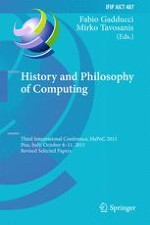2016 | Buch
History and Philosophy of Computing
Third International Conference, HaPoC 2015, Pisa, Italy, October 8-11, 2015, Revised Selected Papers
herausgegeben von: Fabio Gadducci, Mirko Tavosanis
Verlag: Springer International Publishing
Buchreihe : IFIP Advances in Information and Communication Technology
